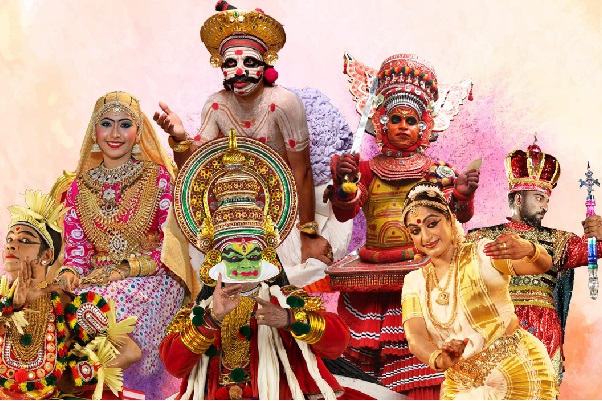Soul in Motion: Exploring the Vibrant Performing Arts of Kerala

PERFORMING ARTS
This can be divided in the basis of religion, entertainment and social factors. Kooth, Thullal and Koodiyattam, Kathakali, and Mohiniyattam are the major art forms that are related to temple which comes under the religious arts.
KOOTH
It is traditionally performed inside the Koothambalam of temples which is specially built to perform Kooth and Koodiyattam in association with Hindu festivals. It is like a monologue which narrates the episodes from the Hindu epics (Ramayana & Mahabharata). The performer is called Chakiyar who also commends on the socio political events in a satirical way with wit and humour. The performer wears a headgear and black moustache with his torso smeared with sandal- wood paste and red dots allover the body. It is the symbolization of the narration by Anantha, the thousand headed snake. Mizhavu and a pair of Ilathalam are the two instruments used for this.
KOODIYATTAM
It is a Sanskrit drama performed by a group of actors in Hindu temple which is recognized as a Masterpiece of the oral and intangible heritage of humanity by UNESCO. The main instruments used are Mizhavu, Kuzhithalam, Edakka, Kurumkuzhal and Sankhu. It is performed by Chakyars (a sub caste of Kerala Hindus) and by Nangyaramma (women of nambiar caste) who performs the role of females. It has three parts; first is Purappadu then follows Nirvahanam and the final part is Koodiyattam.
KATHAKALI
It is a grand art form with a legacy of more than 300 years and is a combination of mime music opera etc… It is originated from Koodiyattam, Krishnanattam, Kalaripaytu and several others. Most of the stories enacted in Kath kali are taken From Ramayana and Mahabharata. Nowadays as a part of popularizing Kerala culture. and tourism the stories from other cultures and mythologies such as Mary Magdalene, Homer’s Iliad etc are also adapted into Kath kali scripts. The actors never speak but enacts purely by the movement of hands (mudras) and by facial ex- pressions (rasas) to the accompaniment of music and instruments in front of a Kalivilakku. The most important aspect is its grand and elaborate make-up. It can be classified into five basic sets namely; pacha, kathi, Kari, Thaadi and minukku according to the different natures and humors of the characters the instruments used are chenda, maddalam, chengila and Ilathalam.